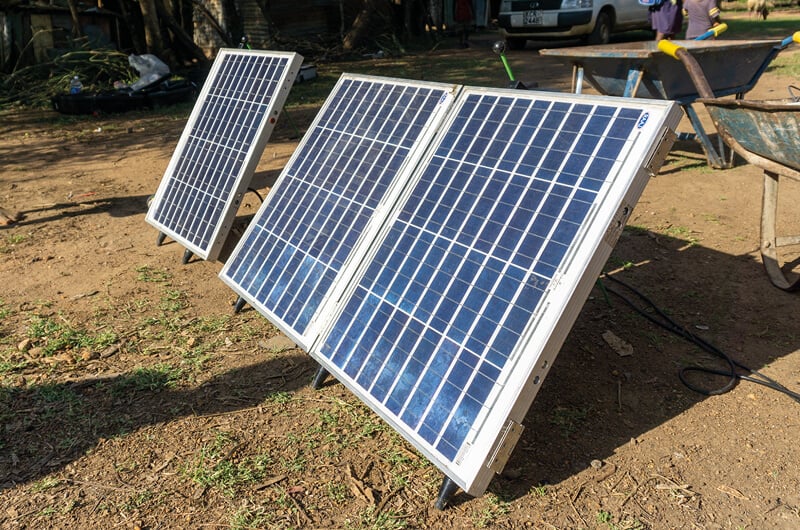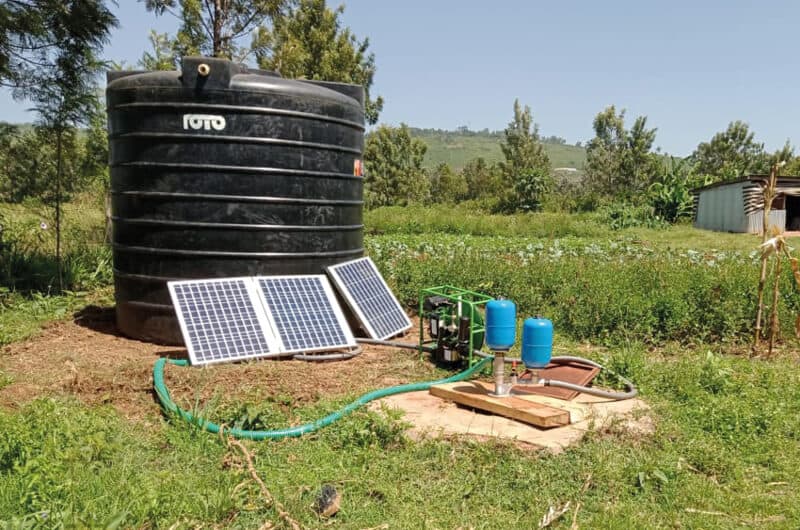
A submersible pump is a pump which must be fully submerged to pump fluid. These pumps are often found in deep wells and boreholes as they are ideal for pumping water from deep below ground. They do not usually suffer from cavitation (the physical limit on sucking water from the surface) as surface pumps do, which means that submersible pumps have revolutionised deep water lifting by pushing water up to the surface.
Within the submersible pump category, different sub-categories exist, based on a variety of engineering principles. The most common types are shown below:
- Centrifugal pumps
- Helical-rotor pumps
- Air-lift pumps
- Deep-well jet pumps
- And submersible hydraulic ram pumps like the FlexExtend
One of the clear differences between these pumps is the way in which they are powered. Submersible centrifugal and helical-rotor pumps are powered by electricity. This can be sourced from the mains, solar, batteries or other renewable sources. Air-lift pumps are powered by compressed air and, both deep-well jet pumps and submersible hydraulic ram pumps (such as the FlexExtend) are powered by water flow generated by a surface pump located at ground level.

Why use a submersible pump?
One of the simplest technical reasons for using a submersible pump is to lift water that is deeper than the suction limit for surface pumps. This is the depth beyond which no surface pump can lift water using suction. This occurs at about 7m (or 20 feet) at sea level and is less for sites at elevation.
Many water sources are at greater depths than the suction limit and therefore require a submersible pump to access water.
If your water is deep underground, you will need a submersible solution.
There are also many other advantages to using a submersible pump:
- A submersible pump will never have to be primed as it is always submerged
- They do not risk drawing in air through small leaks in the pipes or joints which can cause surface-pumps to be very inefficient
- No air, water and noise pollution. Submersible pumps are quiet as they are underground and also cannot contaminate your water source as they require no greasing or oiling or refuelling
- Submersible pumps are versatile in their uses. You can use them for pumping water for agricultural irrigation, domestic water lifting, community water access and much more
How to choose a submersible pump
The things that you should consider when choosing a submersible pump are:
- How far below the surface is your water?
- How far above ground are you wanting to lift water?
- What is your total pumping lift (depth of water below ground plus height of surface water in tank above ground)?
- How much water do you require daily?
- How do you want to power your pump?
- Is your water always very clean or does it sometimes have particulates?
- Is your pump for domestic, agricultural or another use?
These are the questions your pump dealer will need to know answers to in order to help recommend the best solution for you. You may find that many submersible pump datasheets have complex flowrate and depth graphs, so being clear on what you need from the solution before you start looking at specific pumps is an important place to begin.
How different submersible pumps work (the simple version)
Once you have spoken to your pump dealer about your specific requirements, they will suggest pumps to suit your needs. We mentioned some of the most popular types of submersible pumps above and have provided some details on how they work below.
Centrifugal submersible pumps push water up using rotational energy from an impeller (similar to a propellor or fan) inside the sealed pump unit. The spinning impeller increases the fluid’s velocity and pressure, directing it towards the pump’s outlet to generate the water flow.
Helical rotor pumps contain a rotating ‘screw’ which drives water up and out of the well. It is a positive displacement pump which means that the pump moves fluid by repeatedly enclosing a fixed volume of water and moving it through the system.
Air-lift pumps work by mixing compressed air with water. Compressed air is pumped down into the well, mixes with the water and as the air moves to escape up and out of the well it brings water with it.
Deep well jet pumps use a surface pump to pump water down a well at high pressure. A converging nozzle at the bottom of the well then converts this high-pressure water into high velocity water. The water jet is then ducted into the rising pipe, where it pulls the surrounding water up with it.
Submersible hydraulic ram pumps are also powered by a surface pump. The ram pump converts both the output head and water flow from the surface pump to lift additional water to the surface efficiently along with the original surface pump water. The additional water fills the tank at the surface and the original water is recirculated to the surface pump to start the process again.

About the FlexExtend
FlexExtend is a submersible hydraulic ram pump which is suited for pumping clean or dirty water from depths of up to 50m below ground. It is a unique combination of a fixed submersible hydraulic ram pump powered by a surface pump. This makes it a versatile and robust solution ideal for agricultural, domestic and community water access applications, with a market-leading 5 year warranty for peace of mind.
We are currently seeking distribution partners globally. If you are interested in finding out more about distribution opportunities, please contact us today.